4.4 Installing Identity Manager on Windows
This procedure covers the installation of the Metadirectory Server, Web Components, and Utilities for Windows.
Before you begin, make sure your system meets the requirements listed in Table 1-3.
-
Download the Identity Manager .iso image file you need. You can download the Identity Manager .iso image files from the Novell Download site.
The Windows installation of Identity Manager is located on the Identity_Manager_3_5_1_NW_Win.iso or on the Identity_Manager_3_5_1_DVD.iso.
-
After you extract the file, double-click the install.exe file found in the \NT directory.
After the files have finished copying, the Identity Manager Product Installation page appears.
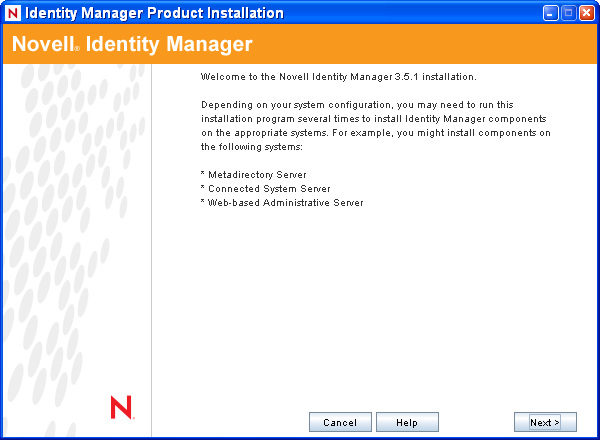
-
Click to begin the installation.
-
Select a language to view the license agreement or use the default (English).
The Identity Manager installation program automatically runs in the language of the machine that you are installing it on. If the installation program has not been translated to the language that your machine uses, it defaults to English.
-
Read the license agreement, then click .
-
Review the Overview pages describing the system types, which include the Metadirectory Server, the Web Components, and the Utilities, then click to continue.
This information is also covered in Table 1-3.
-
On the Identity Manager Install page, select the components you want to install:
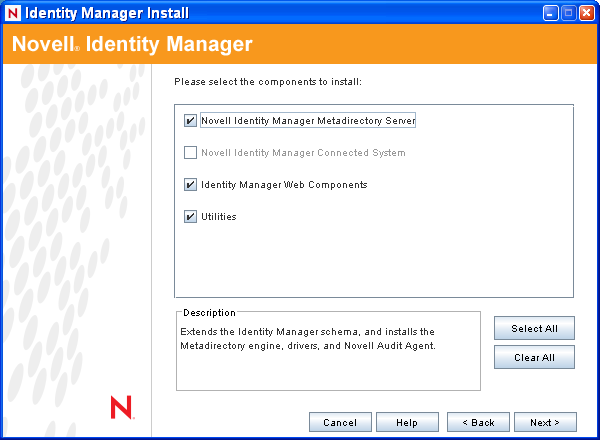
The following options are available:
-
Metadirectory Server: Installs the Metadirectory engine and service drivers. These include Identity Manager Drivers for Active Directory, Avaya, Delimited Text, eDirectory, Exchange, GroupWise, JDBC, JMS, LDAP, Linux/UNIX Settings, Lotus Notes, PeopleSoft, RACF, Remedy, SOAP, SAP, SIF, and Top Secret. Selecting this option also extends the eDirectory schema.
IMPORTANT:Novell eDirectory 8.7.3.6 or 8.8 and Security Services 2.0.5 (NMAS 3.2.0) with current patches must be installed before you can install this option. Install the Metadirectory Server component where you want to run the Metadirectory engine for Identity Manager. If you do not have the correct version of NMAS, you receive a warning message and you lose Identity Manager functionality.
-
Connected System: Installs the Remote Loader that allows you to establish a link between the connected system and a server running the Metadirectory engine. For Windows, this option installs the following drivers: Active Directory, Avaya, Delimited Text, eDirectory, Exchange, GroupWise, JDBC, JMS, LDAP, Linux/UNIX Settings, Lotus Notes, PeopleSoft, RACF, Remedy, SOAP, SAP, SIF, and Top Secret.
Install the Connected System to allow application connection from an application server to an eDirectory-based server running the Metadirectory engine. This procedure is covered under Section 4.5, Installing the Connected System Option on Windows.
-
Web Components: This option installs driver configurations, iManager plug-ins, and application scripts and utilities.
Novell iManager must be installed before you can install this option.
-
Utilities: Installs additional scripts for the JDBC driver and utilities for other drivers. Most drivers don’t have a utility connected to them. Driver utilities can include:
-
SQL scripts for JDBC driver
-
JMS components
-
PeopleSoft components
-
License Auditing tool
-
Active Directory Discovery tool
-
Lotus Notes Discovery tool
-
SAP utilities
-
Scripting Driver Installer and Configuration Tool
Another utility allows you to register the Novell Audit System components for Identity Manager (a valid eDirectory version and a Novell Audit logging server must be installed on the tree before this utility installs.)
-
-
-
Click .
-
Select the drivers you want to install, then click .
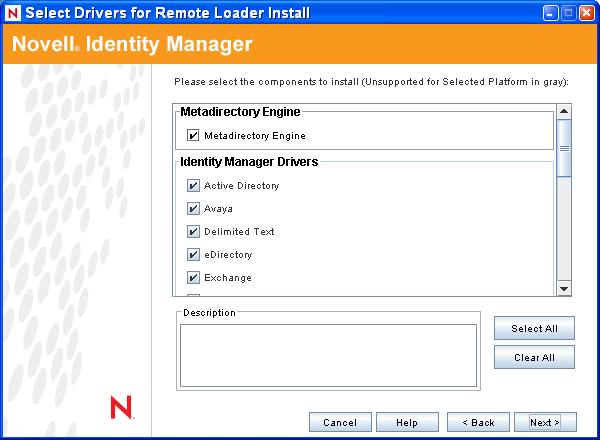
The Select Drivers for Engine Install page shows you which drivers can be installed on a corresponding platform. By default, all available drivers are selected.
We recommend installing all of the driver files, so you won’t need to run the installation program later if you want another driver. The driver files are not used until a driver is configured through iManager or through Designer.
-
When you see the informational message reminding you about product activation, click .
You need to activate the drivers within 90 days of installation; otherwise, they will shut down.
-
When you see the Password Synchronization Upgrade Warning! message, click .
This message is for Windows servers running Password Synchronization 1.0. If you want backward compatibility to 1.0, you must add additional policies to the driver configuration files. Without the policies, Password Synchronization 1.0 works for existing accounts, but not for new or renamed accounts
-
On the Schema Extension page, specify the following:
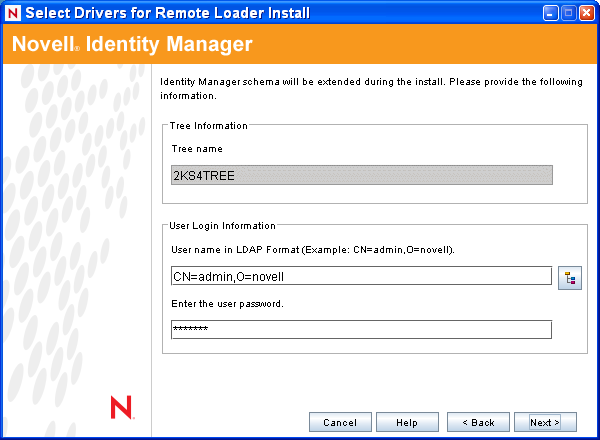
-
User Name: Specify the username (in LDAP format, such as CN=admin,O=novell) of a user who has rights to extend the eDirectory schema (someone who has Supervisor rights to the Root of the Tree, such as Admin).
-
User Password: Specify the user’s password.
-
-
Click . When the user information is validated, you see the first of two Components pages:
On the Select Components To Install page, is selected if you have a valid version of eDirectory and the Novell Audit logging server installed on the tree. Otherwise, it is not selected. The selection installs components for such application systems as JDBC and PeopleSoft.
If the installer detects existing driver configuration files, it moves them to a backup path.
The selection copies the installer for the Client Login Extension to your file system. For more information on the Client Login Extension for Novell Identity Manager, see
Client Login Extension for Novell Identity Manager 3.5.1
in the Novell Identity Manager 3.5.1 Administration Guide. -
Select the components you want to install, then click .
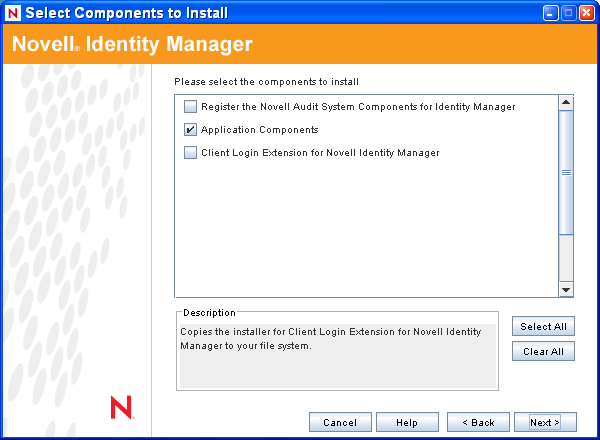
-
An additional page displays to install the Identity Manager plug-ins for iManager, using the SSL Port 443. Click .
-
The second Components page installs the utilities. The Windows installation presents you with an additional page showing the directory where the Application Components are placed. The default is C:\Novell\NDS\DirXMLUtilities. Click .
-
On the Select Components to Install page, platform-specific utilities are dimmed if they are available for platforms other than the one you are installing on. For Windows, all components are available, including SQL Scripts for JDBC Driver, JMS Components, PeopleSoft Components, License Auditing Tool, Active Directory Discovery Tool, Lotus Notes Discovery Tool, SAP Utilities and Scripting Driver Installer and Configuration Tool. Select the components you need and click .
-
If you selected to copy the installer of the Client Login Extension for Novell Identity Manager to your file system, select an installation path or use the default path of C:\Novell\NDS\DirXMLUtilities\cle. Click .
-
Read and verify your selections on the Summary page, then click .

The Novell Identity Manager installation process shuts down eDirectory to extend the schema. The installation process commences installing the selected products and components.
-
After the installation completes and displays the Installation Complete dialog box, click .
-
In order for iManager to recognize the plug-ins you installed, restart your Web services now and restart Tomcat.
If you have installed Identity Manager drivers, use the Identity Manager Configuration Wizard in iManager 2.6 or later, or you can use Designer to configure the drivers.